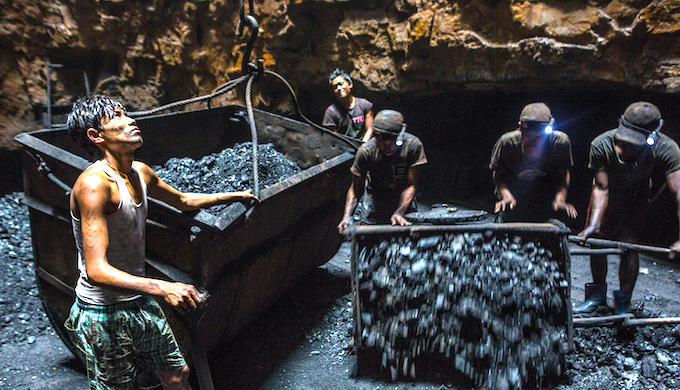The world is undergoing a phase where the energy crisis is posing as a possible hindrance in economies to grow, a threat to inflation and a way to take away the warmth in the winters.
Coal Crisis and lower production of renewable resources adding fuel to the worsening condition of meeting energy needs.
To begin with, the Chinese government’s ambition to be a carbon-neutral country till 2060, is struggling with their lower coal stockpiles. Their government instructed the big manufacturing companies to limit their energy uses which extended to the households, people suffering blackouts.
Though, there is a possibility that China may take a U-turn on its unofficial ban on Australian coal and once again start using the Australian imports.
 India, on the other hand, is also on the verge of power cuts within days. As per the National Power portal, as of mid of October, 116 of India’s 135 coal-fired power plants had only nine days’ coal reserve or less than that, and 84 of the plants were left with less than five days’ fuel stock.
India, on the other hand, is also on the verge of power cuts within days. As per the National Power portal, as of mid of October, 116 of India’s 135 coal-fired power plants had only nine days’ coal reserve or less than that, and 84 of the plants were left with less than five days’ fuel stock.
Several Indian states, including the capital–New Delhi, have flagged concerns with the central government and warned of a possible blackout. Some states have begun to see power outages as plants have declined output in anticipation of coal shortages.
The fear of power cuts shows how countries are heavily dependent on coal for energy — 70% of India’s electricity is generated from coal-fired thermal power plants.
Coal-burning, an environmentally harmful fuel, is one of the biggest reasons behind towering carbon dioxide emissions and the world is preparing to go carbon neutral.
Then, we have the European countries which are grappling with soaring prices of energy, as the supply outstrips demand. It is a stark reminder of how dependent we are becoming on coal to meet our energy needs and now is the time to shift towards renewable forms of energy.
Europeans are making themselves ready for what could be a long, cold and expensive winter for many. Soaring energy costs may take fuel bills to the skies and everyday purchases, including food, may start to cost heavier on the pockets.
So, it is just not our nation that is facing a threat of coal shortage and increasing incidence of power outages. Fuel prices are touching new heights in the international market as energy demand is booming, given economies are recovering from the novel coronavirus disease (COVID-19) pandemic. In addition, Bad weather played its role, including China, the largest producer of coal globally.
International Monetary Fund (IMF) chief economist Gita Gopinath, in an interview with Bloomberg, said, the spike in prices of not just coal but other fuels also, such as crude oil, was unlikely to fuel a 1970s-style oil crisis. It should retreat early next year.
The energy crisis in Europe started to show its colours a few months ago with the prices of natural gas multiplying thrice. Natural gas serves almost a quarter of the energy needs of the continent.
The European Union (EU) gets most of its natural gas from Russia, where bad weather decreased gas production. Also, a political tiff between Russia and the EU over Ukraine aggravated the crisis in the continent as the volume of gas being supplied reduced as per many media reports.
Besides, oil prices have reached new highs as Britain, basically had a windless summer, which means this puts significant stress on electricity generation as it produces almost 24% of its electricity by the wind. Britain had already drifted away from using coal to meet its energy needs and now, again switching to coal will not be an option for them.
Prime Minister Boris Johnson still believes in using wind for electricity generation and says the UK can become “Saudi Arabia of wind power” with offshore wind farms producing enough electricity that can light each UK home within a decade.
Energy Crisis May Pile Pressure On Oil Which Affects Global Climate Warns Global Energy Watchdog
The global energy crisis has created more demand for oil which can prove to be a threat to the world’s climate ambitions, economies recovering from Covid-19 can also suffer and stoke inflation, according to the International Energy Agency.
According to the IEA, gas and coal scarcity in the world’s largest countries, which has made energy markets soar, may ignite a faster-than-expected recovery in the oil market, rising demand above the pre-pandemic levels as early as next year.
According to the Paris-based organisation, this can increase in price for energy-intensive businesses which along with power disruptions can cause a decline in industrial activity and slower global recovery from the epidemic.
“Record coal and gas prices, as well as rolling blackouts, are prompting the power sector and energy-intensive industries to turn to oil to keep the lights on and operations humming,” the IEA said.
In China, the producer price index (PPI) that counts the prices that factories charge to wholesalers for their products saw an increase of 10.7% in September corresponding to the same month last year. China’s factory-gate inflation touched a 26-year-high following a months-long global commodity price rally.
China is dealing with double blows as they are facing soaring commodity prices and blackouts across at least 20 of its 31 provinces.
On the other hand, Oil prices have soared above $80 a barrel – the highest level in three years – as traders see demand outstripping supply for alternative fuels as gas prices rally.
The IEA said with the reduction in the Covid-19 cases, there will be a rise in mobility which will add to the demand for oil, with global fuel demand, at present assimilating in 2 per cent below pre-Covid levels compared with a deficit of more than 10 per cent at the start of 2021.
The IEA raised its demand projections for this year and 2022 by 170,000 bpd and 210,000 bpd, respectively, indicating that global oil consumption is likely to rebound to pre-pandemic levels next year.
The IEA said the increasing energy prices have added “inflationary pressures that, along with power outages, could lead to lower industrial activity and a slowdown in the economic recovery”.
Oil prices are now expected to follow the footsteps of rising global gas prices as demand for crude is touching new highs. The rise in oil demand these days has reached 500,000 barrels a day surpassing the normal, and it has caused market prices to rise more than a quarter, roughly in the last two months. The price of Brent crude is trading at $85 (£62) a barrel, its highest in the last three years.
Energy prices will continue to rise, according to the IEA. It believes oil demand would outstrip supply by 700,000 barrels a day over the remaining year, hinting at possible higher market prices in the weeks ahead. Goldman Sachs, a leading oil trader, also revised its outlook for oil prices, reaching $90 a barrel for this year.
Fatih Birol, the IEA’s executive director, said this week that rising demand for oil and coal might result in the second-largest increase in CO2 emissions in history since governments have not taken advantage of the pandemic’s chance for a “green recovery.”
“We are witnessing an unsustainable recovery from the pandemic,” Birol said, and he called on governments to “come together and give a political message to the world that we are determined to have a clean energy future”.
Birol also dismissed recent claims that the energy price crisis had been partly caused by efforts to make the transition “inaccurate and misleading”. In a clean energy world “the shocks coming from doubling of oil and gas prices will be felt much less by consumers”, he said.
Global GDP growth came down to 5.9 per cent in 2021 by the International Monetary Fund earlier this week, while by 2022 it sees the global GDP at 4.9 per cent as supply chain disruption and the aggravating energy crisis may hit the economic outlook.
“Growth decelerated in Europe and most of Asia, and appears weaker than expected in the US,” the IEA said.
“Now, coal, natural gas and electricity shortages are disrupting economic activity in China, India and elsewhere. Expensive natural gas is not only impacting power generation but also other sectors, like ammonia production, fertiliser plants, refining and manufacturing operations.”
According to the IEA, increasing demand in the last quarter resulted in the largest drain on oil product stockpiles in eight years, with OECD storage levels at their lowest since early 2015.
Global gas markets are expected to stay tighter for longer, even after the next turbulent winter, according to Bank of America Securities analysts.
“The ongoing surge in gas prices keeps making fresh headlines across the globe: Asian spot LNG prices recently hit records >$200/boe – dragging up European and US prices in their wake as strong Asian demand has further globalised formerly regional gas markets.
“We believe the trend is exacerbated by synchronised price rallies in thermal coal and EU carbon – limiting elasticity of supply while price caps limit elasticity of demand.
“We believe delays to LNG developments worldwide risk global gas markets remaining structurally tighter into 2025.”


We all know that the energy crisis is a new type of crisis in the growing industry of each and everything. This is the correct time to find a new source of energy which helpful to generate a continuous amount of electricity. Subscribed your blog.